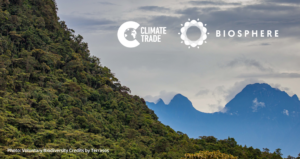
How to Choose a Carbon Offsetting Project
Selecting the right carbon offset project is essential to ensuring your contribution is effective and aligned with your values. At ClimateTrade, we offer a wide range of projects, each with unique environmental and social benefits. Here’s how you can choose the right one for you:
Identify your priorities: Determine whether you want to support renewable energy, reforestation, or other types of projects. Your choice should reflect your commitment to specific environmental and social outcomes.
Explore project details: Dive into the project profiles available on the ClimateTrade Marketplace. Each project is accompanied by comprehensive information, including its location, goals, and the number of carbon credits it generates.
Consider co-benefits: Many carbon offset projects provide additional advantages, such as job creation, poverty reduction, and biodiversity conservation. Think about how these co-benefits align with your values.
Consult the experts: ClimateTrade’s team of experts can help you navigate the marketplace, answer questions, and provide guidance to ensure your carbon offsetting choices are well-informed.
Exploring Carbon Credit Methodologies
Carbon credits are generated through various methodologies approved by international programs such Verified Carbon Standard.
These methodologies determine how emissions reductions are measured and verified, ensuring transparency and credibility in the carbon offset market. ClimateTrade strictly adheres to these standards, ensuring that the carbon credits you purchase are legitimate and verifiable.
Understanding the methodologies behind carbon credits is crucial for evaluating the impact of offset projects. ClimateTrade provides detailed information about the methodologies used in each project, so you can make informed decisions about which initiatives align with your carbon offsetting goals.
Carbon offset projects can be broadly classified into three types, based on the function of their environmental contribution to achieve the net zero target:
Reduction: projects that reduce GHG emissions through energy efficiency measures (such as clean cooking stoves, and clean drinking water) or renewable energy sources like wind and solar energy.
Avoidance: projects that avoid the release of GHG emissions such as forest protection, also called REDD+ projects.
Capture: projects that remove and capture released GHGs directly from the atmosphere (relative to a baseline) through nature-based solutions such as afforestation, reforestation and revegetation (ARR), or technology-based solutions such as direct air capture and carbon storage (DACCS).
- SEO Powered Content & PR Distribution. Get Amplified Today.
- PlatoData.Network Vertical Generative Ai. Empower Yourself. Access Here.
- PlatoAiStream. Web3 Intelligence. Knowledge Amplified. Access Here.
- PlatoESG. Carbon, CleanTech, Energy, Environment, Solar, Waste Management. Access Here.
- PlatoHealth. Biotech and Clinical Trials Intelligence. Access Here.
- Source: https://climatetrade.com/how-important-is-it-to-offset-your-carbon-footprint/
- :is
- a
- About
- accompanied
- Achieve
- Additional
- advantages
- AIR
- align
- aligned
- also
- and
- answer
- approved
- ARE
- AS
- At
- Atmosphere
- available
- avoid
- based
- Baseline
- BE
- behind
- benefits
- broadly
- by
- called
- CAN
- capture
- carbon
- carbon credits
- carbon footprint
- choice
- choices
- Choose
- classified
- commitment
- comprehensive
- CONSERVATION
- contribution
- cooking
- creation
- Credibility
- credit
- Credits
- crucial
- decisions
- detailed
- details
- Determine
- direct
- directly
- dive
- each
- Effective
- efficiency
- Emissions
- energy
- energy efficiency
- ensure
- ensuring
- environmental
- essential
- evaluating
- experts
- Footprint
- For
- forest
- from
- function
- generated
- generates
- GHG
- GHG emissions
- Goals
- guidance
- help
- How
- HTTPS
- Impact
- important
- in
- Including
- information
- informed
- initiatives
- International
- into
- IT
- ITS
- Job
- jpg
- legitimate
- like
- location
- make
- many
- Market
- marketplace
- measured
- measures
- methodologies
- Navigate
- net
- number
- of
- offer
- offset
- offsetting
- on
- ONE
- or
- Other
- outcomes
- plato
- Plato Data Intelligence
- PlatoData
- Poverty
- Profiles
- Programs
- project
- Project details
- projects
- protection
- provide
- provides
- purchase
- Questions
- range
- reduce
- reduction
- reductions
- reflect
- relative
- release
- released
- remove
- Renewable
- renewable energy
- right
- should
- So
- Social
- solar
- solar energy
- Solutions
- Sources
- specific
- standard
- standards
- storage
- such
- support
- Target
- team
- that
- The
- their
- These
- think
- three
- Through
- to
- Transparency
- types
- unique
- used
- Values
- various
- verifiable
- verified
- want
- Water
- we
- whether
- which
- wide
- Wide range
- wind
- with
- you
- Your
- zephyrnet
- zero












